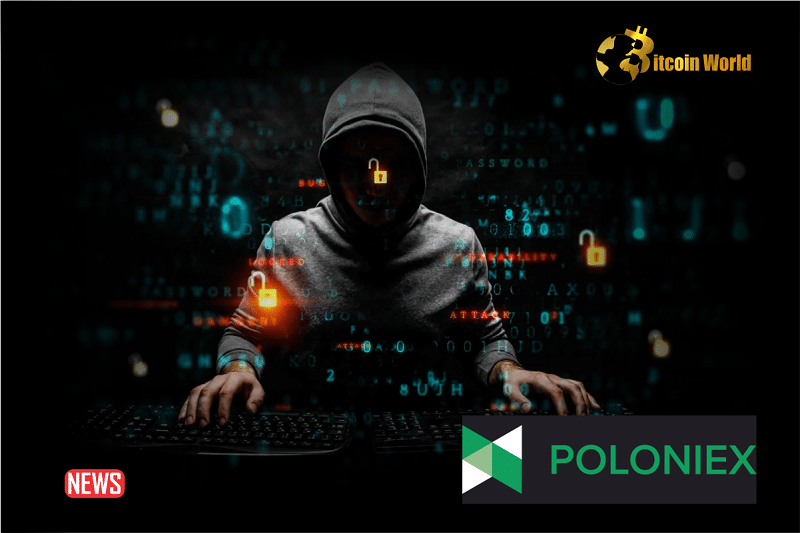Hold onto your crypto wallets! The plot thickens in the ongoing Poloniex saga. Remember the massive hack that rocked the crypto exchange Poloniex, resulting in a staggering $120 million loss? Well, Tron founder Justin Sun isn’t backing down and has dramatically upped the ante in an attempt to recover the stolen digital assets. Buckle up as we dive into the latest developments, including a doubled bounty and a looming deadline for the hackers.
$10 Million on the Table: Is This Enough to Lure Back the Poloniex Hackers?
In a bold move, Justin Sun has personally stepped in, not just with words, but with a significant increase in the white hat bounty. Initially offering a 5% reward, Sun has now doubled it, dangling a cool $10 million carrot in front of the hackers. That’s a hefty sum, even for a haul of $120 million. But is money the only language these cybercriminals understand? Let’s break down what we know:
- Increased Bounty: The white hat bounty has jumped from 5% to a fixed $10 million. This is a clear signal of seriousness from the Poloniex team and Justin Sun.
- Ultimatum Extended (Sort Of): While the initial 7-day deadline for the 5% bounty passed on November 17th, a new, less explicitly stated deadline of November 25th has been issued. This gives the hackers a little more time to consider their options.
- Law Enforcement is Closing In: This isn’t just about a bounty anymore. Sun’s on-chain message explicitly mentions the involvement of law enforcement agencies from the United States, Russia, and China. This suggests a coordinated global effort to track down the perpetrators.
- Assets are Marked: According to Sun, the stolen crypto assets are now being tracked and flagged. This means that any attempt to move or liquidate these funds through legitimate exchanges or financial institutions will likely trigger alarms and lead to asset freezing.
This escalation begs the question: Why the increased pressure? Several factors could be at play:
- Identifying the Hackers: Sun claims the team has “unmasked their identity.” While details are scarce, this suggests that Poloniex and potentially law enforcement have made significant progress in identifying the individuals or groups behind the attack. This knowledge could be a major motivator for increasing the bounty and applying pressure.
- Deterrence and Precedent: A successful recovery of funds, even with a large bounty payout, sends a strong message to other would-be crypto hackers. It demonstrates that exchanges are not defenseless and that there are consequences to such actions.
- User Reassurance: Poloniex is keen to regain user trust after such a significant security breach. Actively pursuing the hackers and attempting to recover funds is a crucial step in rebuilding confidence and demonstrating commitment to user asset security.
The Hacker’s Dilemma: Cash Out or Cut a Deal?
The hackers now face a critical decision. Do they risk attempting to launder and cash out $120 million in marked crypto, with global law enforcement on their trail? Or do they take the $10 million white hat bounty, a substantial sum with no further risk of prosecution (presumably)? Let’s weigh the options:
| Option | Pros | Cons |
|---|---|---|
| Return the Funds for $10 Million Bounty |
|
|
| Attempt to Keep the $120 Million |
|
|
It’s a high-stakes gamble. The promise of $120 million is tempting, but the reality of laundering such a large sum of marked cryptocurrency while evading international law enforcement is incredibly challenging. The $10 million bounty, while a fraction of the total, offers a guaranteed, risk-free (in terms of prosecution) and still substantial reward.
What’s Next for Poloniex and Its Users?
While the hacker’s decision hangs in the balance, Poloniex is working to get back on its feet. In a recent announcement, the exchange stated its intention to resume withdrawal and deposit services within the coming week. This is positive news for users who have been anxiously awaiting access to their funds. However, the specific resumption time is still to be announced, leaving some uncertainty.
It’s important to remember Poloniex’s history. Acquired by Circle in 2018 and then bought by Justin Sun and investors in 2019, the exchange has seen its share of transitions. This hack is undoubtedly a major test of its resilience and its commitment to security going forward.
The Clock is Ticking: Will the Funds Be Returned?
The crypto world is watching closely. Will the increased bounty and the threat of international law enforcement be enough to persuade the Poloniex hackers to return the stolen funds? The deadline of November 25th is fast approaching. This situation serves as a stark reminder of the ongoing security challenges in the cryptocurrency space and the importance of robust security measures for exchanges and users alike. Stay tuned as we continue to follow this developing story and bring you the latest updates.
Disclaimer: The information provided is not trading advice, Bitcoinworld.co.in holds no liability for any investments made based on the information provided on this page. We strongly recommend independent research and/or consultation with a qualified professional before making any investment decisions.


